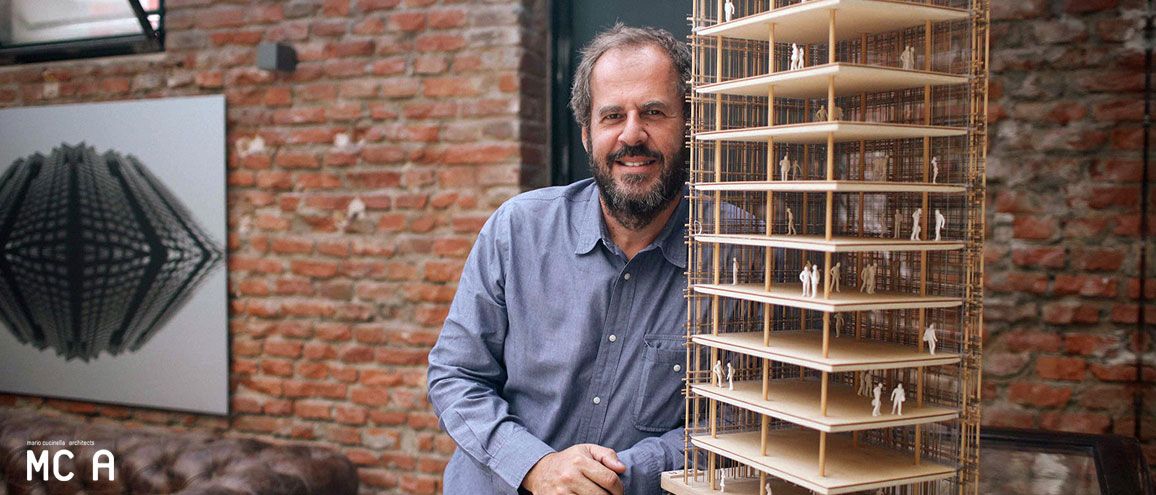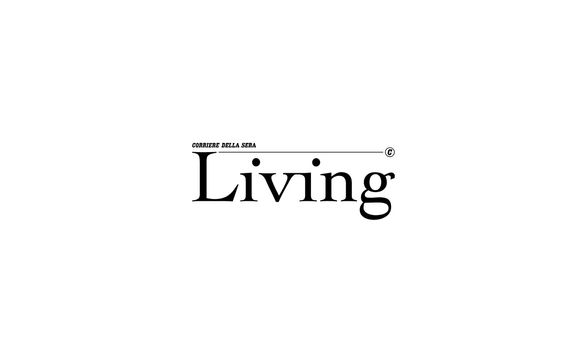Courage, unexpected events and creativity: an interview with the architect

Published
01 Aug 2019
Reading
10 min
By Loredana Mascheroni
Thirty years have gone by since he began his career as an architect at the Renzo Piano Building Workshop. Over these three decades […] Social and environmental aspects occupy a central place in his designs, his university lectures and the work he does for the nonprofit organization Building Green Futures and for SOS – School of Sustainability. Cucinella is definitely on the ascendant. He has recently opened a branch of his practice in New York and his engagement book is full, but he has kept a low profile and doesn’t give himself the airs of architect. With just a few days’ notice, he made himself available for a meeting at the headquarters of Mario Cucinella Architects (MC A), which is located in an out-of-the-way alley not far from Bologna railroad station, in a large industrial space so nondescript that it almost passes unnoticed. He has an imposing build and a low and measured voice that he modulates with intensity, freely interweaving memories with stories of projects.
Let’s start by talking about the cities and the works of architecture that have left a mark on your life and your profession. «I was born in Palermo but spent very little time there. We soon moved to Piacenza, where I went to a nursery school designed by Giuseppe Vaccaro, a Bolognese architect who was a leading figure in Italian modernism. Buildings don’t move, but they are able to travel in your memory: the structure of those spaces, the memory of those desks ranged behind a large expanse of glass through which a lot of sunlight always came in and of the garden surrounded by a low white wall was a source of inspiration for the kindergarten I built at Guastalla in 2015, a project which I’m very fond of. In buildings devoted to education, which are themselves a form of education, the responsibilities of the architect are greater».
When did you first think about becoming an architect? «At high school in Genoa, where I’d been living since I finished primary school. A cousin of my mother’s lived there who had a studio of architecture in the historic center: I was more fascinated by that place filled with drawings than by the workshop which belonged to my father, who was a craftsman. I enrolled in art school and then university where, in those days, there were two courses: figure painting and architecture».
What kind of training did you get from the University of Genoa? «It took a very pragmatic approach. There were good professors in the technical subjects and the scientific-mathematical grounding was very strong—the dean came from the world of engineering—but in composition my teachers were poor. Though I do remember with pleasure the lectures of Guido Campodonico. Then, in the final year, a teacher arrived who had the stature of a Mies van der Rohe: Giancarlo De Carlo. I studied with him up until my thesis».
What did De Carlo give you? «We didn’t have an easy relationship. His intellectual qualities were beyond dispute, but I struggled to understand and accept his particular way of practicing architecture. In him reason prevailed over instinct, and for me, given that I had a great desire to do things, and was driven by great passions, that characteristic of his was almost a limitation. It was not until later that I fully grasped the force of his visionary and poetic reflections, the value of his political and social engagement. The most important legacy that De Carlo has left us consists in having stressed the need to place ethical values alongside technical ones in the practice of architecture».
From De Carlo you passed to Renzo Piano. Another fine school. «In his studio, there was a lively atmosphere and a great desire to do things. A lot of room was given to creativity and there were many stimulating projects to follow. I started with a summer job. I was highly motivated and it didn’t bother me if I spent my time moulding polycarbonate or polystyrene: it was enough to be in that exciting environment. Then I began to work full time, intensely. After four years I was ready for a change, I wanted to go my own way. Genoa was a very fine city, but not an open one. I thought about moving to Paris and Renzo suggested I apply to Jean Nouvel, but I ended up in Piano’s studio on Rue Sainte-Croix-de-la-Bretonnerie».
Did you find what you were looking for in Paris? «It was a beautiful and stimulating city, a breath of fresh air after Genoa. It was there that I saw all the films of Pasolini and Fellini for the first time. But the experience at the Renzo Piano Building Workshop didn’t last long. The problem, with people who are great at what they do is that they get in your way. At a certain point you have to break away from them».
What was the trigger that made you take flight? «A series of lucky coincidences. I had won a competition held by the United Nations for the International Union of Architecture. I had prepared it in the evenings, after finishing my work in the studio. This was in the month of April in 1992. In Italy the Tangentopoli scandal had broken out, but in Paris the atmosphere was completely different: a lot of competitions had been announced for the area of the Grande Arche de la Défense. I had found out that one of the studios in Le Corbusier’s Maison Planeix in the 13th arrondissement was free, having been rented just for the time needed to work on one of those competitions. I had the keys after chatting for an hour with the owner, between cigarettes and drinks. At just that moment, Renzo decided to move his offices to Rue des Archives and to buy new furniture. He gave me his old stuff and offered me a consultancy contract for six months, to help me tackle the break from the economic viewpoint. I spent the first three years working on competitions on the first level of that studio and living on the second. Over time the office grew. We won two or three competitions and worked on projects in Italy too».
Then, in 1999, you moved the practice to Bologna. Why did you decide to come back to Italy? «I was tired of the demanding pace of a metropolis like Paris, of living in a beautiful condominium where I knew nobody. I landed up in Bologna on my way from Paris to the Marche, where I was overseeing the project for the new headquarters of iGuzzini. I liked its “medium” scale, finding it to be a city with great potential».
In the years you’ve been working in Italy you’ve honed the aspects of design linked to sustainability, adopting specific practices applied to housing and city planning. Today many people are using the word “green,” perhaps in a superficial way. What are the requisites of sustainable design? «If used improperly, the word quickly loses its meaning. Its real significance concerns the transition from the age of fossil fuels to the so-called post-carbon era. A necessary passage that stems from an awareness of the fact that the world in which we live needs to be taken care of. Imagining sustainable buildings means entering into a profound dialogue with the climate and with the location, utilizing little technology and working a great deal on form and on materials – materials that are playing an ever more active part in the attainment of the result, in that they are capable of doing an invisible job within a new circular economy. The way ahead is not an easy one, but there are no alternatives: there is no future without sustainability».
One of your most important projects from this perspective was the 100K House, but it was never built. «It guaranteed zero emissions of CO2 thanks to the integration of photovoltaic cells into the architecture and the adoption of a whole range of structural devices that made the apartment house a perfect bioclimatic machine. We tried to carry out this project first at Settimo Torinese, then in Lodi and finally in Calabria, hoping for the backing of municipal councils – it was a social housing project – but we have not got off the starting blocks. I’m not giving up». […]
How much does research count in your work? «It’s fundamental. I have a special team that focuses on environmental and climatic analysis. Research also helps me in my architectural and aesthetic choices, and reinforces my philosophy, which can be summed up by the concept of “creative empathy,” that is trying to understand a place in all its complexity and using creativity to shape the design. An architectural practice is a cultural enterprise, it is not concerned solely with making a profit. Through research we anticipate the responses to possible demands». […]
Milan is at the center of your activities. Do you think it is a city ready to accept your design philosophy? «The economic and political structure of Milan is creating the right conditions to embark on quality projects. There are people who are investing in the city, and for this reason a lot of interesting things, very different from one another, have happened and are happening. And the political world is an important agent in these changes. It is showing courage». […]
The theme of reconstruction is a tragically topical one. What is the most correct way to intervene? «There are two ways: reconstructing after the earthquake and through prevention. It will require at least two generations to work on the existing heritage, developing a system of diagnostics that is able to deal with the structural problems of buildings. Restoring damaged buildings is also a way of getting new economies going. I believe that a serious policy of prevention ought to studying ways of providing incentives from this perspective, similar to the ecobonus (a system of tax credits designed to encourage energy efficiency). We have everything we need to find out how to tackle the problem seriously. It will be our own fault if we do nothing».
All this in Bologna. But the MCA has now landed in New York too. «We are at the beginning of a wonderful story, I’m certain of it. It’s an investment that we will be making over the next ten years. I will spend part of my time in America. It’s important to live in places where the energy is high. In the United States there is a complicated market and a lot of conflict, because it’s a country made up of many different people, but there is a lot of faith too. It always takes a hint of recklessness to tackle new and unexpected things, but the unexpected is a fundamental component of creativity. If it doesn’t work, we will come home with a fine American experience and a bit more energy. You’re arriving in the United States with Trump in charge, an emblem of the denial of global warming and other threats to the environment. This is certainly not a minor detail for an architect with your approach to design. The position taken by Trump with respect to climate change may produce a strong reaction in defense of the environment. For this reason, it makes even more sense today to be playing an active part on the American scene».









